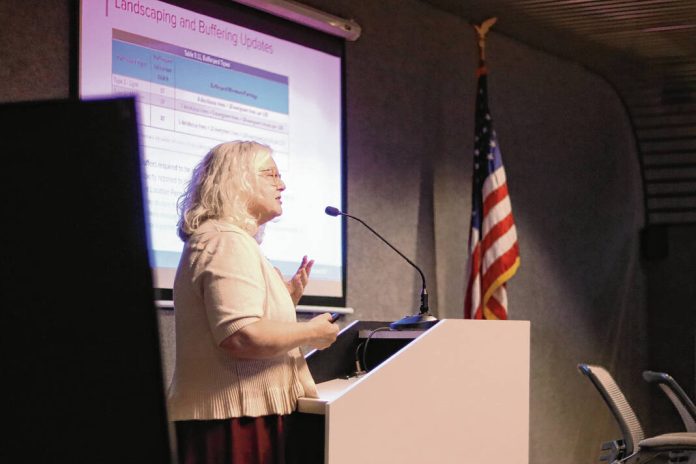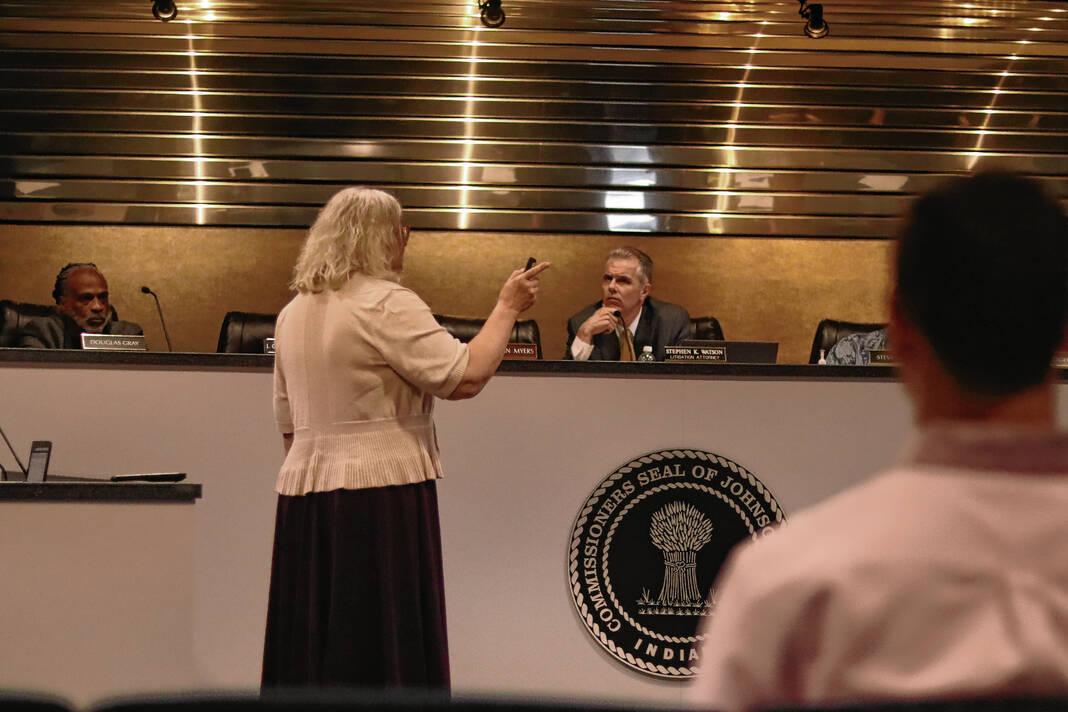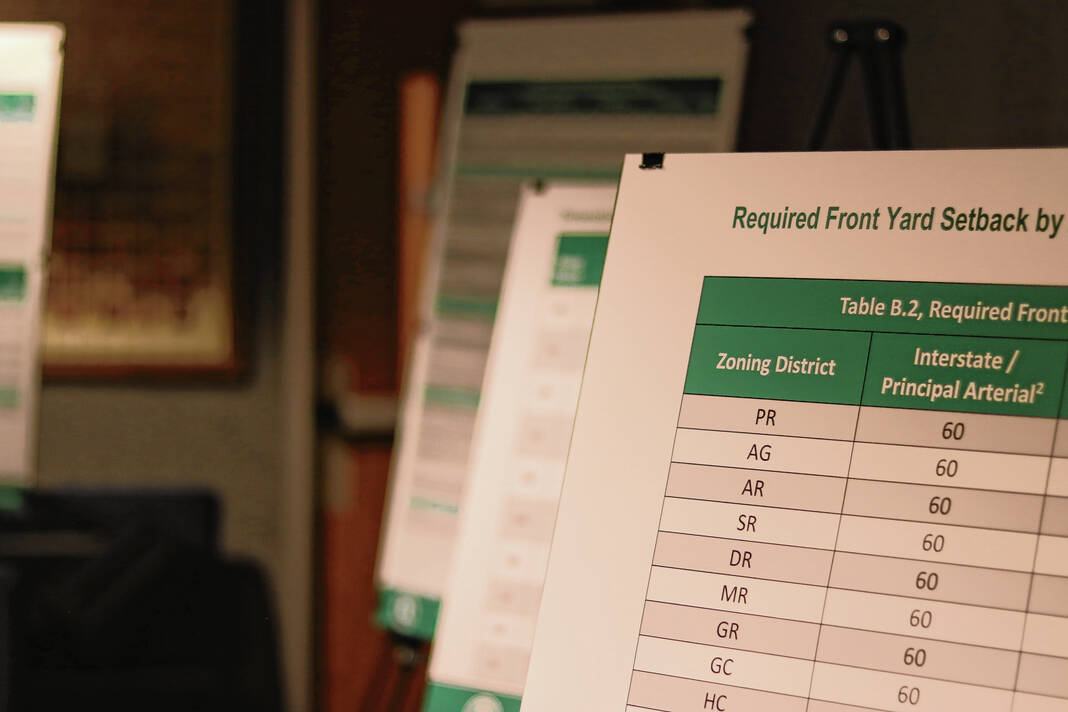The law of the land for county zoning could soon change for residents and developers.
The Johnson County Advisory Plan Commission hosted an open house Thursday where consultants presented key information on a proposed Unified Development Ordinance, or UDO. The Johnson County Department of Planning and Zoning is updating the ordinance with help from consultants American Structurepoint Inc. and The Planning Workshop Inc. If approved, the new UDO will determine zoning rules and guidelines that residents and developers in the county must follow.
For the ordinance, officials took the county’s existing standards — specifically zoning and subdivision ordinances — and combined them into a draft UDO. The UDO streamlines processes, definitions and zoning chapters to make a guiding document that’s easier to interpret and follow, said Matthew O’Rourke, of American Structurepoint.
The document includes changes from the current ordinance including the addition of graphics and tables, new land uses, updates for state, federal and case law, modern best practices, implementation for plan recommendations and clarity, officials said.
The current zoning and subdivision ordinances were first adopted in 2002, with the zoning ordinance last being updated this year and the subdivision ordinance last being updated in 2018.
The draft UDO can be viewed here.
Subdivisions
The proposed UDO presents a new process for approving small subdivisions and new subdivision types.
K.K. Gerhart-Fritz, president of The Planning Workshop, said the changes for minor residential subdivisions would simplify the process. A minor subdivision consists of three or fewer lots and can only be approved for residential and agricultural uses. A common reason a minor subdivision is requested is to build several homes that are connected to a county road by driveways rather than a new street.
There would only be one minor subdivision per parent parcel under the proposed UDO, which is designed to prevent someone from abusing the rule by making multiple minor subdivisions to avoid the requirements of a major subdivision.
Consultants proposed that minor subdivisions would go to a new subcommittee of the planning committee called the plat committee.
“The idea here is that these (are) … the easy things that don’t have a lot of controversy, that are minor — no new roads, things like that. Those can have a faster, easier process,” Gerhart-Fritz said.
Appeals of the plat committee’s decisions would go to the plan commission. The plat committee would forward an application to the plan commission if there is an appeal or if they feel it the commission is better suited to make the decision, according to the presentation.
The proposed UDO also details a new type of subdivision called the agricultural minor subdivision, Gerhart-Fritz said. Consultants heard a lot about loopholes and issues related to subdivisions in agricultural areas and this type is meant to be a tool for farmers “to allow them to sell property, to exchange property, etc. — not to become a developer,” she said.
For major residential subdivisions, there is the new major traditional residential subdivision, which features grided streets and smaller lots, and the new major conservation residential subdivision that lets someone set aside or preserve environmentally attractive areas, unique areas and groups homes as a compact neighborhood on the remaining portion.
To make sure subdivision applicants apply to create the correct type of subdivision, the proposed new UDO requires a pre-submittal meeting with county planning staff, according to the presentation.
Landscaping and buffering
New proposed rules for landscaping and buffering add flexibility for design and substitutions.
This gives developers the ability to design landscaping and buffering to best suit the parcel and nearby land uses.
“One of the things we heard from staff input was to make it a little more flexible so that everything doesn’t have to be just like a marching of trees and there can be a little more flexibility with design and layout, a little less formal,” Gerhart-Fritz said.
Consultants also proposed adding landscape preservation incentives or credits that encourage preservation. Gerhart-Fritz said it isn’t a requirement to preserve trees, but if someone has a big shade tree and preserves it, for example, then fewer things need to be planted.
There were other changes, including adding foundation planting requirements and provisions for landscaping substitution too. It would also prohibit some plants like noxious weeds and the Indiana Department of Natural Resource’s Invasives and Plants of Regulatory Concern from being planted.
Leaving out exempt subdivisions
There was also discussion about a proposed change to remove the concept of “exempt subdivision” and whether it should be added back in. Exempt subdivisions don’t have to go through as rigorous a process compared to traditional subdivisions.
“I’ll be perfectly honest, that was the problem area,” Gerhart-Fritz said. “There was a lot happening there that people were developing and the county was having to come back later, spend a lot of county resources on road improvements and all kinds of things. So we’ve heard from multiple sources about issues with exempting people from having to go through the subdivision process.”
The minor agricultural process mirrors exempt subdivisions so that properties can still be looked at but not go through the major subdivisions process, said David Baird of American Structurepoint. However, he said, if exempt subdivisions don’t impact the problems they’ve heard from the agricultural community, then the consultants would be comfortable having a section on exemptions.
Nonconformity
The new UDO has a proposed section that includes information on nonconformity. The old ordinance failed to address what happens if something doesn’t comply with ordinance standards, Gerhart-Fritz said.
“Any time you do an amendment to an ordinance, any time you adopt a new ordinance, things will become nonconforming,” she said, “And what that means is that they were built originally under a law that they met at the time or they were developed under a law they met at that time but they don’t meet the new law.”
Gerhart-Fritz said with the new proposed UDO, things that are nonconforming can continue exactly as they are and won’t have to come into compliance with new standards unless any changes are made.
Agriculture nonconforming uses are treated differently than other land uses in state law, so the proposed new UDO makes that clear, Gerhart-Fritz said. The consultants also added additional zoning districts as possibly being nonconforming and clarified that nonconforming structures can’t be demolished more than 50% and then rebuilt while following old requirements unless the structure is destroyed by an act of nature.
Variances
For development standards variances, consultants proposed adding two criteria outside state law based on what they’ve seen other places around Indiana adopt, particularly in central Indiana.
The proposed criteria would state that the variance is the minimum amount necessary and does not correct a hardship caused by a former or current owner of the property.
County officials recommended the proposed variance criteria be reviewed by the Board of Zoning Appeals, as they are the board that handles variances.
Next steps
Consultants estimate that the final draft of the new UDO will be ready for consideration at the earliest in July, although it may be ready later. The plan commission will give a recommendation to county commissioners on whether the new document should be adopted and there will be another public hearing at a later date.
Where to learn more
To learn more about the proposed Unified Development Ordinance https://shorturl.at/GHuPo. The website displays draft chapters of the UDO.










